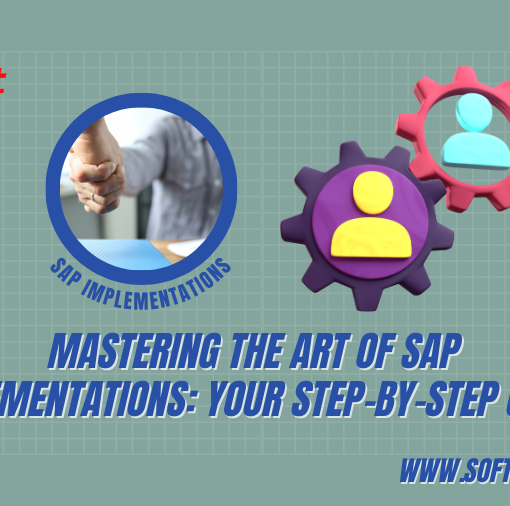Navigating the SAP Ecosystem: From Modules to Solutions – A Comprehensive Guide
The vast terrain of the SAP ecosystem, with its towering modules and sprawling solutions, can feel overwhelming for any explorer. It’s like walking into a tech bazaar brimming with tools, each promising to solve a specific business need. But where do you begin? How do you find the right tools and assemble them into a cohesive, high-performing solution that propels your business forward? Worry not, intrepid adventurer, for this blog is your roadmap to deciphering the SAP landscape and building a tailor-made solution for your unique business journey.

Understanding the Building Blocks: The SAP Modules
The SAP ecosystem rests on a foundation of powerful modules, each specializing in a distinct business function. Let’s delve into some key players:
- SAP S/4HANA: The crown jewel, a next-generation ERP system that integrates and manages core business processes like finance, procurement, manufacturing, and sales. Think of it as the central command center.
- SAP C/4HANA: A customer-centric suite encompassing marketing, sales, service, and commerce solutions. It’s your key to nurturing relationships and driving customer success.
- SAP SuccessFactors: Your secret weapon for empowering your workforce. This Human Capital Management (HCM) solution manages talent acquisition, performance, learning, and payroll.
- SAP Ariba: Streamlines your procurement process, connecting you with a global network of suppliers and automating transactions. It’s your ticket to efficient and cost-effective sourcing.
- SAP HANA Cloud Platforms: Provides a flexible foundation for building innovative applications, extending functionality, and integrating data. Think of it as your canvas for digital transformation.
From Modules to Solutions: Building Your Dream Team
Now that you know the players, it’s time to build your dream team. But instead of cherry-picking individual modules, think holistically.
- Identify Your Business Needs: Start by understanding your pain points, growth aspirations, and industry demands. What challenges do you need to overcome? What opportunities do you want to capitalize on?
- Map Your Journey: Chart your course, outlining the desired business outcomes and how each module can contribute. Think of it as plotting your route to the summit.
- Integrate and Collaborate: Modules are powerful, but they shine brightest when they work together. Seamless integration ensures data flows freely and processes orchestrate flawlessly.
- Embrace Best Practices: Leverage SAP’s expertise and pre-configured industry solutions. These pre-built templates provide a head start, speeding up implementation and ensuring alignment with industry standards.
Beyond the Core: Exploring the Extended Ecosystem
The SAP universe doesn’t stop at its core modules. A thriving ecosystem of partners and third-party solutions exists to cater to specialized needs and industry nuances.
- SAP Partner Ecosystem: Leverage the expertise of SAP partners for implementation, customization, and ongoing support. These partners are your guides, helping you navigate the terrain and optimize your solution.
- SAP AppCenter: Discover a treasure trove of ready-to-deploy solutions built by SAP and its partners. These add-ons address specific industry needs, enhance functionalities, and extend the capabilities of your core SAP system.
Navigating the Challenges: Obstacles and Opportunities
No journey is without obstacles. Here are some challenges to anticipate and overcome:
- Change Management: Implementing a new system requires adaptability and communication. Prepare your team for the shift and address concerns head-on.
- Data Migration and Integration: Data is the lifeblood of your system. Ensure accurate and seamless migration from legacy systems to avoid chaos.
- Customization vs. Standardization: While customization can address specific needs, it can also increase complexity and maintenance costs. Seek solutions within the standard configuration first.
- Staying Current: The SAP landscape constantly evolves. Invest in ongoing training and updates to keep your solution future-proof.
Reaching the Summit: Measuring Success and Beyond
Once your solution is up and running, don’t lose sight of the summit – success.
- Define Key Performance Indicators (KPIs): Determine how you will measure the impact of your SAP solution. Align KPIs with your business goals and track progress regularly.
- Embrace Continuous Improvement: Never settle. Continuously seek ways to optimize your solution, explore new functionalities, and leverage the latest innovations.
- Share the Glory: Celebrate your achievements and showcase the value your SAP solution delivers to your organization.
Conclusion: Bon Voyage, Explorer!
Navigating the SAP ecosystem is an adventure filled with challenges and rewards. By understanding the landscape, choosing the right tools, and adapting to the terrain, you can build a customized solution that propels your business to new heights. So, bon voyage, intrepid explorer! May your journey be smooth, your decisions wise, and your summit view breathtaking.
You may be interested in:
A Deep Dive into SAP Multi Resource Scheduling (MRS)
SAP Order Management: Streamline Your Business Operations




